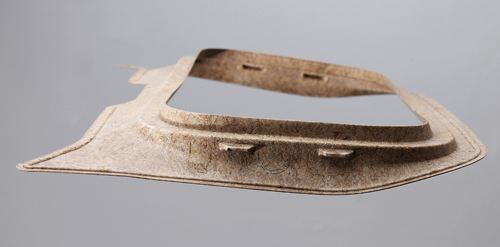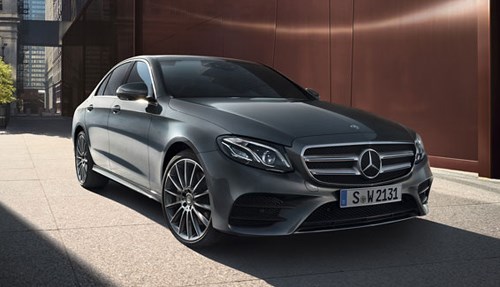IAC debuts FiberFrame on 2017 Mercedes-Benz
Germany-based International Automotive Components (IAC) has launched its ultra lightweight FiberFrame natural fiber sun roof frame on the 2017 Mercedes-Benz E-Class.
Automotive interiors supplier International Automotive Components (IAC; Düsseldorf, Germany) has launched its FiberFrame natural fiber sun roof frame on the 2017 Mercedes-Benz E-Class. The proprietary innovation is made of 70% renewable raw material content and provides up to 50% in weight saving compared to conventional metal-reinforced steel sun roof frames. The new Mercedes-Benz E-Class marks the mass-production debut of IAC's interior solution.
IAC's FiberFrame replaces the sun roof's metal reinforcement frame with a lighter frame employing strong, natural fibers using a new raw material comprised of 70% renewable content. This unique lightweight solution is reinforced using IAC's EcoMatHot natural fiber-based semi-finished material, which was especially developed for this application. The fiber mat is molded with a thermoset binder provided by BASF (see below) and is manufactured in-house by IAC in a hot molding process.
The new product has high stiffness for improved structural rigidity and enables up to 50% in weight saving compared with conventional steel frames. Compared to conventional thermoplastic frames, FiberFrame also prevents warpage after climate testing. In addition, mold tooling concepts for IAC's FiberFrame have much shorter lead times than conventional steel molding tools.
"Sun and panoramic roofs are increasingly popular across all vehicle sizes and segments," says IAC director of advanced engineering Fritz Schweindl, located at the company's Ebersberg, Bavaria, technology center. "This market trend inspired IAC to develop stiff and lightweight concepts, which help realize different fixation concepts on the car body, the sun roof or the panoramic roof module. Within its strategy of viable innovation, IAC leveraged its integrated material and process know-how to provide our OEM customers with significant weight savings, a lower carbon footprint for their vehicles and a more efficient production process."
"In the specification of the IAC EcoMatHot fiber mat, as well as in terms of tooling technology and production process of this innovation, we were able to take advantage of more than 20 years of experience working with natural-fiber-reinforced materials in automotive interiors," says Schweindl. "By manufacturing this product in-house in our headliner plant, we follow our strategy and expansion of vertical integration of our interior systems. Thanks to our global manufacturing footprint and standardized processes, we are now able to adapt IAC FiberFrame to customer needs and supply it around the world."
FiberFrame started production in November 2015 at IAC's Center of Excellence for overhead products in Prestice, Czech Republic, to support the Mercedes-Benz E-Class launch. The company also produces the headliner, the outer-rear wheel house liner, inner wheel house cover and rear seat cover for the vehicle.
FiberFrame binder
The Acrodur 950 L binder used in the FiberFrame system, provided by BASF (Ludwigshafen, Germany), is said to provide the necessary loading capacity and heat resistance of the lightweight component. As an alternative to phenolic resins, the water-based and low-emission binder strengthens the natural fibers and thus enables an environmentally compatible, dimensionally stable and lightweight solution for car roof frames.
“Natural-fiber roof frames based on Acrodur 950 L are around 40% lighter than roof frames made from metal. Hence, we help car makers achieve their sustainability targets because lighter vehicles consume less fuel and have lower carbon emissions,” explains Thorsten Habeck, head of marketing for Dispersions for Fiber Bonding at BASF.
“It was easy to integrate the BASF binder into our production system. The natural fiber components that are strengthened with Acrodur are ideal to mold; they are environmentally friendly and save time during the production of the composites,” says IAC's Schweindl. “Furthermore, the product is low in emissions, which means that it is safer to work with.”
Related Content
Otto Aviation launches Phantom 3500 business jet with all-composite airframe from Leonardo
Promising 60% less fuel burn and 90% less emissions using SAF, the super-laminar flow design with windowless fuselage will be built using RTM in Florida facility with certification slated for 2030.
Read MoreBladder-assisted compression molding derivative produces complex, autoclave-quality automotive parts
HP Composites’ AirPower technology enables high-rate CFRP roof production with 50% energy savings for the Maserati MC20.
Read MoreRevisiting the OceanGate Titan disaster
A year has passed since the tragic loss of the Titan submersible that claimed the lives of five people. What lessons have been learned from the disaster?
Read MorePrepreg compression molding supports higher-rate propeller manufacturing
To meet increasing UAV market demands, Mejzlik Propellers has added a higher-rate compression molding line to its custom CFRP propeller capabilities.
Read MoreRead Next
Ceramic matrix composites: Faster, cheaper, higher temperature
New players proliferate, increasing CMC materials and manufacturing capacity, novel processes and automation to meet demand for higher part volumes and performance.
Read MoreCutting 100 pounds, certification time for the X-59 nose cone
Swift Engineering used HyperX software to remove 100 pounds from 38-foot graphite/epoxy cored nose cone for X-59 supersonic aircraft.
Read MoreUltrasonic welding for in-space manufacturing of CFRTP
Agile Ultrasonics and NASA trial robotic-compatible carbon fiber-reinforced thermoplastic ultrasonic welding technology for space structures.
Read More




























